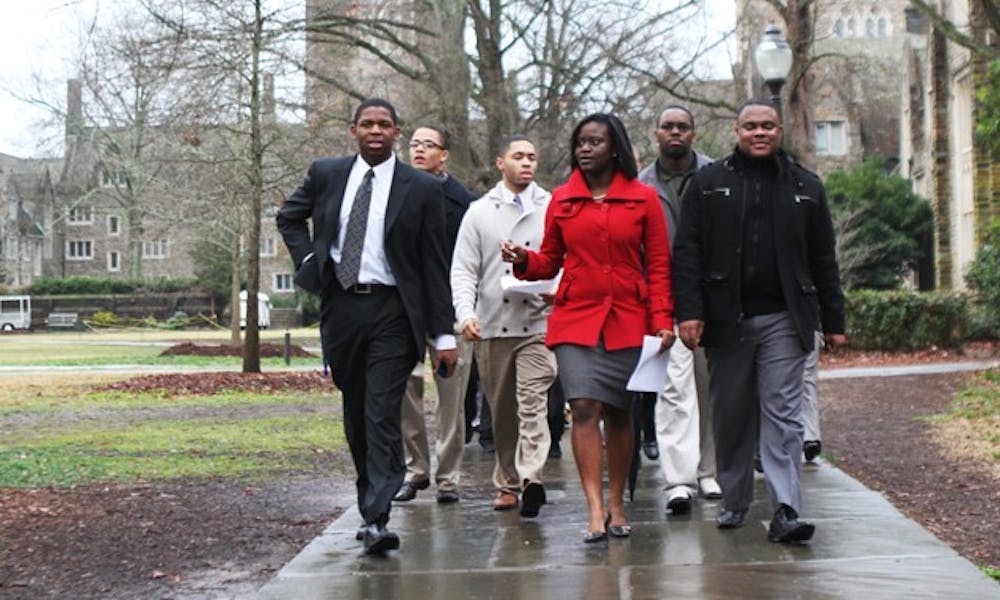The Black Student Alliance is calling on Duke’s leaders to fully address the concerns of the black community.
About 20 BSA members presented the Black Culture Initiative to Michael Schoenfeld, vice president for public affairs and government relations, Tuesday morning. The document outlines present concerns of black students, one of which is the relocation of the Mary Lou Williams Center for Black Culture, as well as recommendations on how to address them. BSA members walked from the Bryan Center to the Allen Building at 9 a.m., asking to speak to President Richard Brodhead, who was away from the office at a previously scheduled meeting.
“Duke is failing to realize that the black community is the Duke community,” said BSA President Nana Asante, a senior, after the presentation to Schoenfeld.
The concerns motivating the Black Culture Initiative are of great importance to the University, Schoenfeld said, who agreed to share the document with other senior administrators.
“We welcome the call to action,” Schoenfeld said in an interview. “Many people have been working for a long time to create a positive climate for African-American students. We look forward to ongoing conversations with BSA and others about ways that we can improve.”
In the initiative, BSA recommended that the Mary Lou Williams Center for Black Culture return to the West Union Building after renovations. Among other requests were that the University form an endowment to supply funding for culturally significant programming, academic enrichment and development; a renewed commitment and expansion of the Black Student Alliance Invitational weekend; and an explanation of the role of special considerations and affirmative in the admissions process.
BSA also asked that the University form a working group tasked with assessing and improving the academic and social climate for black students at Duke. The document also includes a request to increase the number of black faculty and administrators.
The document compares these requests to the Duke Women’s Initiative launched in 2003 under former Duke President Nannerl Keohane.
In an email to Asante Tuesday, Brodhead commended BSA for communicating its concerns and agreed to meet with the group to further discuss the Black Culture Initiative.
“I have read your proposal, and first want to offer my appreciation and respect for your thoughtful approach to this important issue,” Brodhead wrote. “I will be discussing your letter with my colleagues in the administration, and would welcome the opportunity to meet with you and the other members of BSA soon.”
Asante noted the administration’s need to study the campus climate, socially and otherwise.
“I hope this email is followed and supported by the action that they claim to move forward in the name of,” she said in a interview.
Administrators have not been forthright in responding to the concerns raised by BSA in the recent past, said the group’s Executive Vice President Marcus Benning, a sophomore. Tuesday’s presentation in the Allen Building followed several earlier attempts by BSA to schedule a meeting with administrators. This plan placed the administration in a position to address BSA members directly.
Benning noted that the controversy over the recent study conducted by Duke faculty comparing grade point average and race was not a primary concern for BSA. The larger issue pertains to the implications of the study and the “less than adequate” response from the administration, he said.
“We don’t feel that Duke’s senior academic officials directly addressed our concerns in their [letter] to The Chronicle,” Benning said in an interview. “They didn’t mention the words ‘race,’ ‘black’ or the phrase ‘affirmative action’ in their response [to the study], and we feel that this was a deliberate attempt to avoid directly addressing the issues at hand: the study directed at black students, uncertainty around the location of the Mary Lou Williams Center and BSAI.”
Going forward, Benning wants BSA and the administration to work together to rectify the concerns expressed in the initiative.
“It’s about University officials not directly addressing the issues in the research, and not providing any recommendations to narrow the achievement gap, if such academic disparities exist,” he said.
Get The Chronicle straight to your inbox
Signup for our weekly newsletter. Cancel at any time.

